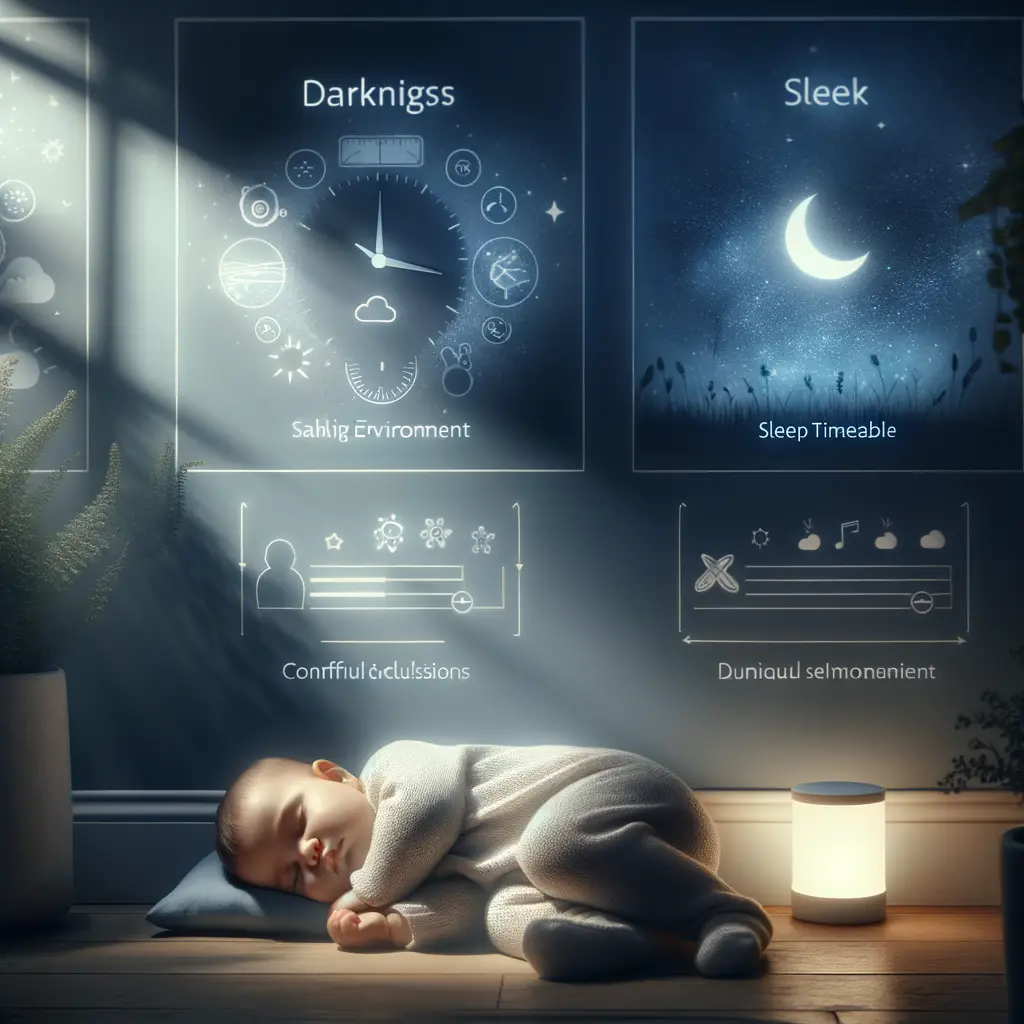Introduction: Unveiling the Truth About Baby Sleep Patterns
Welcome to our comprehensive guide on baby sleep patterns. In this post, we aim to debunk common misconceptions and highlight the importance of understanding your baby’s sleep schedule. Let’s dive in!
Common misconceptions about baby sleep habits
Many parents believe that babies should sleep through the night, but this is not always the case. According to Wikipedia, it’s normal for babies to wake up several times during the night. This is because their sleep cycles are shorter than ours, and they need to eat more frequently. Another common misconception is that babies who don’t sleep well are problematic. In reality, each baby has a unique sleep pattern, and what works for one might not work for another.
Importance of understanding baby sleep schedule
Understanding your baby’s sleep schedule is crucial for their health and development. A regular sleep schedule helps regulate their body’s internal clock and promotes better sleep in the long run. It also allows parents to plan their day and get some much-needed rest. Remember, a well-rested baby is a happy baby!
Stay tuned as we delve deeper into the world of baby sleep, exploring how darkness can influence sleep patterns and sharing practical tips and techniques to improve your baby’s sleep.
Understanding Baby Sleep in Darkness

When it comes to ensuring a good night’s sleep for your baby, the role of darkness is often overlooked. However, it plays a significant part in regulating your little one’s sleep patterns. Let’s delve into the science behind this phenomenon.
The Science Behind Darkness and Infant Sleep
Darkness is not just an absence of light; it has a profound impact on our bodies, especially when it comes to sleep. This is even more true for infants. Here’s how:
How darkness affects the baby’s sleep cycle
Our bodies have an internal clock, known as the circadian rhythm, which is heavily influenced by light and darkness. When it gets dark, our bodies produce a hormone called melatonin, which helps us sleep. For babies, this process is still developing. Darkness helps their bodies recognize it’s time to sleep, leading to a more regular sleep cycle.
Research studies on baby sleep in darkness
Several studies have shed light on the relationship between darkness and baby sleep. A research found that babies who sleep in complete darkness tend to sleep longer and wake up less often during the night. This is because darkness helps increase melatonin production, promoting better sleep.
In conclusion, understanding the role of darkness in your baby’s sleep is crucial. It not only helps regulate their sleep cycle but also promotes longer, more restful sleep. So, when it’s bedtime for your little one, make sure the room is as dark as possible.
Benefits of Dark for Baby Sleep
Darkness plays a crucial role in promoting healthy sleep patterns in babies. Here are some of the key benefits:
Improving Baby Sleep Quality
Darkness triggers the production of melatonin, a hormone that helps regulate sleep. When a baby’s room is dark, it signals to their brain that it’s time to sleep, which can lead to a deeper and more restful sleep. According to a Wikipedia article on melatonin, this hormone is crucial for maintaining our sleep-wake cycle.
Promoting Longer Sleep Duration
Darkness not only improves the quality of sleep but also its duration. Babies who sleep in a dark room tend to sleep longer and wake up less frequently during the night. This is because the absence of light cues helps maintain their internal body clock, leading to more consistent sleep patterns.
Supporting Healthy Growth and Development
Quality sleep is essential for a baby’s growth and development. During deep sleep, the body releases growth hormones that aid in the development of the brain and the body. Furthermore, good sleep can enhance a baby’s mood, cognitive abilities, and overall health. Therefore, creating a dark environment for sleep can contribute significantly to your baby’s well-being.
In conclusion, a dark environment can significantly improve a baby’s sleep quality, promote longer sleep duration, and support their healthy growth and development. So, consider making your baby’s room as dark as possible during their sleep time.
Improving Baby Sleep: Practical Tips and Techniques

Getting your baby to sleep can sometimes feel like a challenge. But don’t worry, there are practical tips and techniques that can help. Let’s start by creating the ideal baby sleep environment.
Creating the Ideal Baby Sleep Environment
Just like adults, babies need a comfortable and soothing environment to get a good night’s sleep. Here are some key factors to consider:
Importance of a dark room
A dark room is essential for your baby’s sleep. Darkness triggers the brain to release melatonin, a hormone that helps us sleep. Keeping the room dark can help your baby understand that it’s time to sleep. You can use blackout curtains or shades to block out any outside light.
Appropriate room temperature
The temperature of the room can greatly affect your baby’s sleep. A room that is too hot or too cold can make your baby uncomfortable and disrupt their sleep. The ideal room temperature for a baby is between 68-72 degrees Fahrenheit (20-22 degrees Celsius).
Comfortable bedding and sleepwear
Comfortable bedding and sleepwear can also improve your baby’s sleep. Choose soft, breathable fabrics for your baby’s sleepwear and bedding. Avoid any loose bedding that could be a suffocation hazard. Your baby’s crib mattress should be firm, with a fitted sheet.
By paying attention to these factors, you can create an environment that encourages your baby to sleep. Remember, every baby is unique and what works for one might not work for another. It’s all about finding what works best for your baby.
Baby Sleep Tips: Establishing a Routine
Establishing a routine for your baby’s sleep is crucial in ensuring they get the rest they need. Here are some tips to help you create a consistent sleep schedule for your little one:
Consistent Bedtime and Wake-up Time
Setting a consistent bedtime and wake-up time can help regulate your baby’s internal clock, making it easier for them to fall asleep and wake up at the same times each day. According to a study, babies who follow a consistent sleep schedule have fewer nighttime awakenings and longer total sleep time.
Pre-Bedtime Rituals and Activities
Creating a calming pre-bedtime routine can signal to your baby that it’s time to sleep. This could include activities like a warm bath, reading a book, or singing a lullaby. These rituals not only help your baby wind down but also create a strong association between these activities and sleep.
Daytime Naps and Their Impact on Night Sleep
Daytime naps are important for your baby’s growth and development. However, it’s important to strike a balance. Too many naps or naps that are too long can interfere with nighttime sleep. It’s recommended that babies under one year should have two to three naps per day, with each nap lasting between 30 minutes to two hours.
Remember, every baby is unique and what works for one might not work for another. It’s important to observe your baby’s sleep patterns and adjust the routine as needed. With patience and consistency, you’ll be able to establish a sleep routine that works best for your baby.
Common Questions About Baby Sleep and Night Light
One of the most common questions parents have is about the use of night lights in their baby’s room. Is it helpful or harmful? Let’s explore this topic in detail.
Is a Night Light Helpful or Harmful?
Using a night light can be both beneficial and potentially harmful, depending on various factors. Let’s delve into the pros and cons of using a night light.
Pros and Cons of Using a Night Light
On the positive side, a night light can provide a sense of comfort and security for your baby, especially if they are afraid of the dark. It can also make nighttime feedings and diaper changes easier for parents, reducing the need to switch on bright overhead lights.
However, there are potential downsides. Some studies suggest that constant light exposure can disrupt a baby’s sleep cycle and even affect their vision. It’s also important to consider the type of light used. Blue or white lights can interfere with the production of melatonin, a hormone that helps regulate sleep.
Choosing the Right Night Light for Your Baby
When choosing a night light, consider one that emits a soft, warm glow rather than a bright light. Red or orange lights are less likely to interfere with melatonin production. Also, look for a night light with a timer or dimmer switch so you can control the amount of light in the room.
Remember, every child is unique. What works for one baby may not work for another. It’s important to observe your baby’s sleep patterns and adjust accordingly. If you notice your baby is having trouble sleeping with a night light, it may be worth trying a few nights without it to see if their sleep improves.
When Can Babies Start Sleeping in the Dark?
Many parents wonder when their little ones can start sleeping in the dark. The answer is not as straightforward as you might think, as it depends on the individual child’s comfort level and fear of the dark. Let’s delve into this topic further.
Understanding your baby’s fear of the dark
It’s important to note that fear of the dark typically doesn’t develop until around the age of two or three. Before this age, babies are usually not afraid of the dark. However, every child is unique, and some might show signs of fear earlier than others. It’s crucial to understand your baby’s fear of the dark and respond to their needs accordingly.
Transitioning to a dark room: step-by-step guide
Transitioning your baby to a dark room can be a gradual process. Here’s a simple step-by-step guide to help you:
Start with a dim light: Begin by dimming the lights in your baby’s room during sleep time. This can help them get used to the idea of sleeping in a darker environment.
Gradually reduce the light: Over time, gradually reduce the amount of light in the room until it’s completely dark. This should be done over a period of weeks or even months, depending on your baby’s comfort level.
Provide comfort: If your baby shows signs of fear, comfort them and reassure them that they are safe. You could also consider using a night light or leaving the door slightly open.
In conclusion, the transition to sleeping in the dark is a process that should be tailored to your baby’s needs and comfort level. Remember, patience is key in this transition. With time, your little one will be able to sleep in the dark without any fear.
Conclusion: Embracing the Dark for Better Baby Sleep
As we draw this informative journey to a close, it’s important to recap and reflect on the key insights we’ve gathered. The darkness isn’t something to be feared, but rather, it’s a natural and beneficial element that can significantly improve your baby’s sleep quality.
Recap of the benefits of dark for baby sleep
Throughout this article, we’ve learned that darkness plays a pivotal role in regulating your baby’s sleep patterns. It triggers the production of melatonin, a hormone that helps your baby to fall asleep and stay asleep. The dark environment also minimizes distractions, allowing your baby to settle down faster and sleep more soundly. In fact, studies have shown that babies who sleep in dark rooms tend to sleep longer and wake up less frequently during the night. (source)
Final thoughts and key takeaways
Embracing the dark for better baby sleep isn’t about plunging your child’s room into pitch blackness. It’s about creating a calm, soothing, and distraction-free environment that encourages restful sleep. Remember, consistency is key. Establishing a regular sleep routine with a darkened room can help your baby associate darkness with bedtime, making the transition to sleep smoother and easier.
In conclusion, the dark isn’t a foe, but a friend in the realm of baby sleep. By understanding its benefits and implementing practical techniques, you can help your baby embrace the dark and enjoy better, more restful sleep. Remember, every baby is unique. What works for one might not work for another. So, don’t be afraid to experiment and find what works best for your little one.














